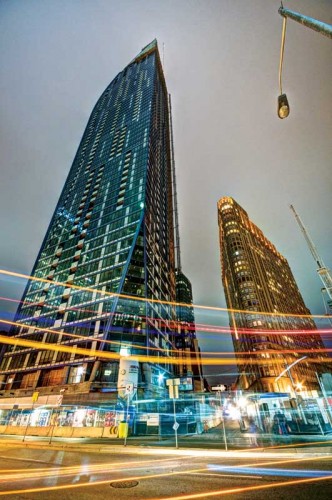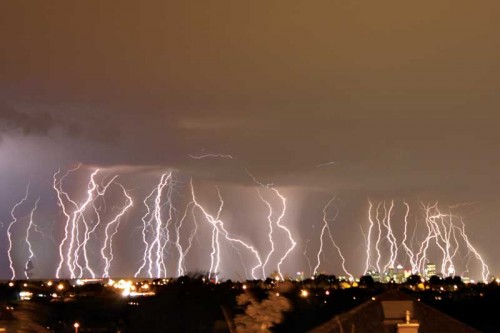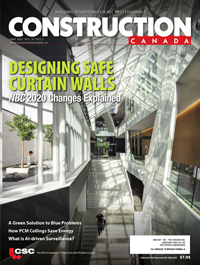Lightning Protection: Five concepts you need to understand

by Jennifer A. Morgan, CSI, and Michael Chusid, RA, FCSI, CCS
It is not necessary for most building design and construction professionals to know everything about lightning protection systems (LPS); just the following key points:
- Lightning can pose a significant danger to building structures, occupants, and contents.
- Building designers have a professional responsibility to advise clients regarding lightning-related risks.
- Lightning protection systems complying with CAN/CSA-B72-M87, Installation Code for Lightning Protection Systems and standards from the National Fire Protection Association (NFPA), UL, and the Lightning Protection Institute (LPI) are highly effective.
- Lightning protection can be implemented with minimal impact to the building’s appearance.
- Specifying an LPS can be simplified by stipulating the standards and delegating design to qualified lightning protection professionals.
1. Risk considerations
Cloud-to-ground lightning occurs in Canada about 2.34 million times a year, including about once every three seconds during the summer months. Lightning is a discharge of static electricity that can send 300 million volts and 30,000 amps through the atmosphere or whatever objects lie in its path between clouds and ground. The burst of energy can trigger fires, cause structural and physical damage, and disrupt electronic and other building services. It also injures or kills 175 Canadians in a typical year. (This data from Environment Canada can be found at www.ec.gc.ca/foudre-lightning/. The site has additional information about lightning and lightning safety, including the Canadian Lightning Danger Map (CLDM) representing areas at greatest risk of being struck by lightning in the next 10 minutes. If storms are forecast or seem imminent, CLDM should be consulted frequently by those engaged in or responsible for outdoor events and activities.)
Lightning-related damage and disruption costs the Canadian economy between $600 million and $1 billion each year. Nearly $40 million of this is allocated to property damage. The Council of Canadian Fire Marshals and Fire Commissioners (CCFMFC) estimates lightning causes around one per cent of building fires. The insurance industry estimates lightning-related property damage claims range in number from 3900 to 5250 per year. The report from which these statistics are extracted summarizes:
The estimated impact of lightning in terms of damage and disruption to Canadians is very large and likely much greater than that attributed to other forms of hazardous weather (i.e. tornadoes, hail, and hurricanes) over the long term.(For more information, see Mills et al’s report, “Assessment of Lightning-related Damage and Disruption in Canada,” published in Natural Hazards.)
Lightning density (frequency/area) is pronounced throughout the lower latitudes from the Maritimes to the eastern slopes of the Rockies and especially in Southern Ontario. Yet, every province is at risk. For example, lightning sparks over half the wildfires in British Columbia. (For more info, visit www.bcwildfire.com/Weather/lightning.htm)
While tornadoes, hurricanes, and floods garner more headlines, lightning is the most frequent weather-related disaster, and vulnerability to lightning is increasing. (Mills [note 2] finds that lightning causes substantial damage in aggregate; however, isolated incidents do not command the kind of media attention given to other types of disasters. As an example, the Category F4 tornado in Edmonton on July 31, 1987 received far more reportage than did the 40,000 lightning strikes scattered throughout Alberta on the same day. A media phenomenon further reducing awareness occurs when many architectural photographers remove air terminals before images are published, thus reducing the public and professions awareness of lightning protection.) According to recent climatological research, global warming could boost the frequency of lightning strikes by 50 per cent. There is also growing recognition that lightning protection contributes to building and community resilience. (See D. Romps et al’s article, “Projected Increase in Lightning Strikes in the United States Due to Global Warming,” from Science in the November 2010 edition. The editor summarizes: “Lightning occurs more frequently when it is hotter than when it is colder. They predict the number of lightning strikes will increase by about 12 per cent for every degree Celsius of rise in global average air temperature.”)
Concurrently, the need for lightning protection is becoming more urgent as buildings are increasingly filled with sensitive electronic devices and systems. The dramatic zigzag bolt from the heavens is the most typical image of lightning. Yet, damage also occurs when arcs leap from one structure into another, and when electrical surges travel for kilometres through power or telephone lines. These remote strikes can fry circuits in computers, appliances, equipment, security systems, light-emitting diode (LED) lighting, electronic door hardware, fire alarms, and other mission-critical devices.
The true extent of this type of damage is underestimated because it is not always associated with lightning. For example, when a major hospital conducted a routine test of a new backup generator it found a nonfunctional circuit board, which was assumed to be a manufacturing defect. The board was replaced but was, again, inoperable at the next routine inspection. Only after several such incidents was the correlation between the failures and thunderstorms realized. No further failures have occurred since an LPS was installed.
Finally, builders should have training and management protocols to protect workers against lightning. This is of particular concern on large sites, since shelter for workers may be located at a distance. The best advice is, “When thunder roars, go indoors.”(See “Lightning Safety on the Job” www.lightningsafety.noaa.gov/job.htm)

2. Professional responsibility
Neither national or provincial building and electrical codes require lightning protection. Instead, the decision to install lightning protection is at the discretion of building owners and their risk management advisors, insurance underwriters, and design professionals. Yet, surveys of architects reveal several Catch-22 challenges. (While not specifically requiring lightning protection per se, several provinces have acts regarding licensing of lightning protection installers and requiring them to conform to CAN/CSA-B72-M1987. Some governmental agencies, including National Defense and Alberta Infrastructure require lightning protection on certain structures. The National Building Code (NBC) suggests (but does not mandate) compliance with the CSA standard. One should consult local authorities having jurisdiction (AHJs) for clarification.)
For example, most architects do not consider lightning protection unless a client asks for it. This is problematic because most building owners rely on their architect to provide professional guidance on technical issues.
An owner’s expectation, in this regard is in line with the Royal Architectural Institute of Canada (RAIC). It states: “Architects serve as trusted advisors… while serving the public interest and addressing health and safety matters.”(Visit https://www.raic.org/raic/what-architect for more information.)
An additional problem arises because most architects assume the electrical engineer will deal with the LPS. Alas, most engineers provide only the grounding and surge protection required for the building’s electric power system, and not for lightning protection.
The architectural stance appears to contradict the RAIC’s statement that:
It is important for the success of your project that the architect—who is uniquely trained and experienced in this regard—be responsible for the overall management of sub-consultants throughout the entire project. This enables the architect to produce well-integrated results by coordinating both the design and administration of the project. (See www.raic.org/raic/how-choose-architect#subconsultants)
An architect should ask himself or herself the following question: “If my client suffers a lightning-related loss, how can I demonstrate I have met the industry’s standard of care?”
Fortunately, a solution to this question is provided in CAN/CSA B72 Appendix A, General Principles of Lightning Protection. (A more detailed risk analysis is in NFPA 780 Annex L, www.nfpa.org/codes-and-standards/document-information-pages?mode=code&code=780. An online application for performing calculations based on NFPA 780 Annex L can be accessed online by visiting www.ecle.biz/riskcalculator)









